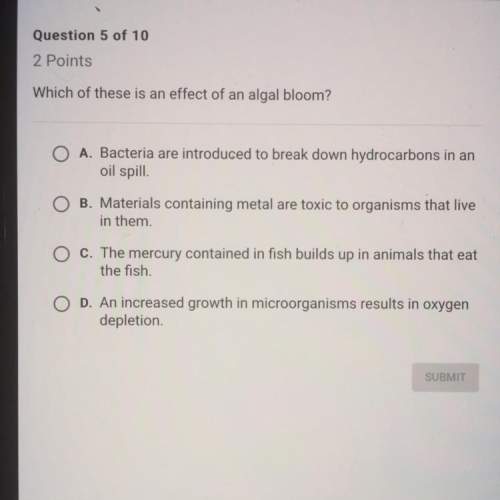
Biology, 30.06.2019 01:30 algahimnada
E. coli is a species of bacteria that causes many different infections in humans. certain e. coli strains have developed resistance to antibiotics, making infections with these strains difficult to treat. how do bacteria such as e. coli, which reproduce asexually, gain new traits such as antibiotic resistance? a. by mutating their dna in response to environmental conditions to gain beneficial traits b. by adapting to changes in environmental conditions without undergoing changes in their dna c. by producing offspring with new gene assortments from genetic recombination, which increases diversity in a population d. by undergoing spontaneous mutations when they replicate, which increases genetic variation in a population

Answers: 1


Other questions on the subject: Biology

Biology, 21.06.2019 16:00, jdvazquez18p7a7vs
Which are forms of nitrogen that are usable by humans
Answers: 1

Biology, 21.06.2019 23:10, gobbler80
Getting out of bed is the first goal i tackle each day. 2several small goals are achieved by me as the day progresses. 3when i am riding the bus home or walking the dog, i think about the bigger goals i have for my life. which statement correctly describes the verb tense, aspect, and voice in this paragraph? a. sentences 1 and 2 contain present progressive verbs. sentence 3 contains both present progressive and simple present verbs. sentence 2 uses passive voice. b. sentences 1 and 2 contain simple present verbs. sentence 3 contains present progressive verbs. all three sentences use active voice. c. sentences 1 and 2 contain present progressive verbs. sentence 3 contains simple present verbs. all three sentences use active voice. d. sentences 1 and 2 contain simple present verbs. sentence 3 contains both present progressive and simple present verbs. sentence 2 uses passive voice.
Answers: 3

Biology, 21.06.2019 23:30, iwantcandy2002
Considering the yellow and green pea color phenotypes studied by gregor mendel: a. what is the biochemical function of the protein that is specified by the gene responsible for the pea color phenotype? (1 point) b. a null allele of a gene is an allele that does not specify (or encode) any of the biochemical function that the gene normally provides (in other words, either no protein at all or only non-functional protein is produced from it). of the two alleles, y and y, which is more likely to be a null allele? (1 point) c. in terms of the underlying biochemistry, why is the y allele dominant to the y allele? (2 points) d. why are peas that are yy homozygotes green? (1 point) e. the amount of protein produced from a gene is roughly proportional to the number of functional copies of the gene carried by a cell or individual. what do the phenotypes of yy homozygotes, yy heterozygotes, and yy homozygotes tell us about the amount of sgr enzyme needed to produce a yellow color? explain your reasoning. (2 points)
Answers: 1
You know the right answer?
E. coli is a species of bacteria that causes many different infections in humans. certain e. coli st...
Questions in other subjects:

Social Studies, 20.08.2019 23:00

Mathematics, 20.08.2019 23:00







Physics, 20.08.2019 23:00





